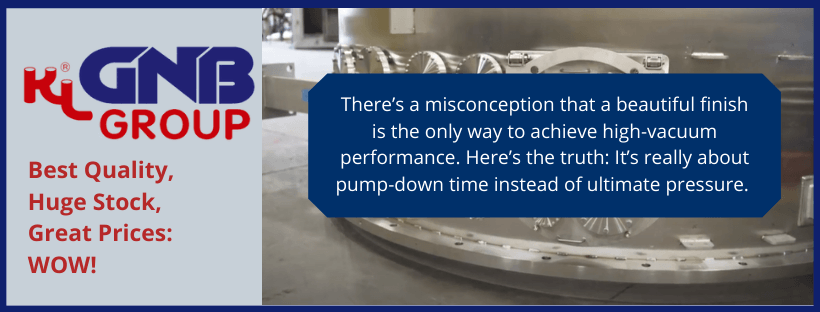
Like the body paint of a new car, the surface finish inside a vacuum chamber can have an impact on the overall cost. In some cases, surface finishes can double the material cost and add time to the manufacturing of the vacuum chamber. But unlike a new vehicle, the surface finish isn’t just about looks.
Let’s clear up some misconceptions about surface finishes within vacuum chambers.
It’s important to know that there are three primary reasons for improved surface finishes. Beyond desirable aesthetics of the vacuum chamber, the surface finish can improve the ease at which the chamber can be cleaned. The smoother the finish, the easier it is to maintain the surface. Truly, cleaning and scrubbing down the vacuum chamber is made easy with the right surface finish. Thirdly, a quality and well-applied surface finish will also affect the pump-down speed.
Within the vacuum chamber, water molecules can slow the pump down time. Water vapor is one of the most difficult gases to pump out of a chamber. That’s because the humidity from the air can become attached to the chamber walls and other surfaces. As a result, the water molecules can get embedded deep within crevices. Extracting this moisture is not easy to do, and as the water molecules slowly leave the surfaces, they add to the gas load.
There’s a misconception that a beautiful finish is the only way to achieve high-vacuum performance. Here’s the truth: It’s really about pump-down time instead of ultimate pressure. Efficient pumping out, more so than overall pressure, is the key to ultra-high performance. With the proper surface finish, vacuum chambers exposed to atmospheric moisture will perform at a higher level.
Depending on the application, various surface finishes will get the job done. Plates directly from the steel mill, for instance, are not exactly conducive to releasing their gas load because of their rough surface texture.
Bead blasting will smoothen the rough steel mill finish. Bead blasting is cost-effective and will vastly improve the surface finish. It is commonly used for numerous vacuum chamber applications.
For further smoothing, many customers opt for a No. 4 grained finish. This is accomplished by uniformly sanding in one direction with 150-grit sandpaper, or something finer, to achieve a smooth finish.
A 2B surface finish, on the other hand (only available in thinner sheet stock), is a shiny and reflective surface. While it is a good vacuum chamber finish, GNB can enhance this surface finish even more, to improve its pump-down performance.
Upon completion of the mechanical polishing operations, electropolishing can increase the smoothness of the surface finish. This electro-chemical reaction further polishes remaining surface roughness and removes iron molecules from the surface of stainless steels.
The various types of surface finishes can get complicated, but it’s important to know that the pump-down times will improve with each level of finish.
GNB embraces the challenges and demands of being a leader in the high vacuum products, components and surface finishes that meet your specifications. From improving pump-down times and saving customers money to building a chamber to meet a budget, our goal is to implement a chamber with a surface finish that fits your precise needs. Our team can help determine the proper surface finish for your specific application. We also want to ensure that all customers can obtain the best value for the application.
Our ambitious standards for quality and performance are second to none. We will always deliver on world-class products and service through our experience, expertise and constant pursuit of excellence so our customers say, “Wow!”. Please contact us today to learn more about our performance-enhancing surface finishes for vacuum chambers.
